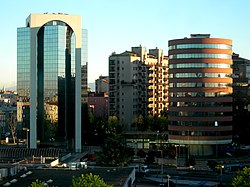Sesto San Giovanni: Difference between revisions
Undid revision 404808083 by Hillibilli (talk) |
Undid revision 405027427 by 98.204.74.45 (talk) |
||
| Line 44: | Line 44: | ||
'''Sesto San Giovanni''' is a city and ''[[comune]]'' in the [[Milan metropolitan area]], located in the [[province of Milan]] and region of [[Lombardy]] in [[Italy]]. It is home to the northernmost stop of the [[Milan Transportation System|Milan metro]] M1 line. The city is informally referred to as "Sesto". |
'''Sesto San Giovanni''' is a city and ''[[comune]]'' in the [[Milan metropolitan area]], located in the [[province of Milan]] and region of [[Lombardy]] in [[Italy]]. It is home to the northernmost stop of the [[Milan Transportation System|Milan metro]] M1 line. The city is informally referred to as "Sesto". |
||
An |
An unimportant agglomerate of buildings until the 19th century, Sesto San Giovanni grew during the end of the 19th century and in the early 20th century, becoming the site of several industries, such as [[Falck]], [[Campari]], [[Magneti Marelli]] and [[Ansaldobreda, S.P.A.|Breda]]. In that period the population increased rapidly, from 5,000 inhabitants in 1880 to 14,000 in 1911. After [[World War II]], Sesto became populated by many migrants from other parts of Italy, leading to an increased population of 95,000 inhabitants in 1981. Sesto was in the past referred to as the [[Stalingrad]] of Italy, due to the strong historical presence of the Italian communist party ([[Italian Communist Party|PCI]]). |
||
Because of its diverse and growing industries, the [[Milan]] suburb has drawn many migrants. Some 9.52% of the population is not [[Italian people|Italian]]. 2.97% of the population is [[North African]] [[Arab]], 2.06% is other [[European ethnic groups|European]], and 1.90% is from the [[Asia]]n continent.[http://demo.istat.it/str2005/index.html] |
Because of its diverse and growing industries, the [[Milan]] suburb has drawn many migrants. Some 9.52% of the population is not [[Italian people|Italian]]. 2.97% of the population is [[North African]] [[Arab]], 2.06% is other [[European ethnic groups|European]], and 1.90% is from the [[Asia]]n continent.[http://demo.istat.it/str2005/index.html] |
||
In the 1990s, Sesto San Giovanni suffered an |
In the 1990s, Sesto San Giovanni suffered an economic crisis, and most of the historical companies closed their offices in the city. The town partially succeeded in converting its economy from producing steel to service industries and software activities. Several large companies opened offices in Sesto, such as [[Asea Brown Boveri|ABB Group]], Wind, [[Impregilo]] and [[Oracle Corporation]]. |
||
Sesto received the honorary title of city with a presidential decree on April 10, 1954. |
Sesto received the honorary title of city with a presidential decree on April 10, 1954. |
||
Revision as of 19:07, 30 December 2010
Sesto San Giovanni | |
|---|---|
| Città di Sesto San Giovanni | |
 Downtown Sesto San Giovanni | |
| Country | Italy |
| Region | Lombardy |
| Province | Milan (Mi) |
| Frazioni | Rondò-Torretta, Rondinella-Baraggia-Restellone, Isola del Bosco-delle Corti, Pelucca-villaggio Falck, Dei Parchi-Cascina de' Gatti-Parpagliona |
| Government | |
| • Mayor | Giorgio Oldrini (Democratic Party) |
| Area | |
| • Total | 11.7 km2 (4.5 sq mi) |
| Elevation | 140 m (460 ft) |
| Population (30 April 2009)[2] | |
| • Total | 81,279 |
| • Density | 6,900/km2 (18,000/sq mi) |
| Demonym | Sestesi |
| Time zone | UTC+1 (CET) |
| • Summer (DST) | UTC+2 (CEST) |
| Postal code | 20099 |
| Dialing code | 02 |
| Patron saint | St. John the Baptist |
| Saint day | June 24 |
| Website | Official website |
Sesto San Giovanni is a city and comune in the Milan metropolitan area, located in the province of Milan and region of Lombardy in Italy. It is home to the northernmost stop of the Milan metro M1 line. The city is informally referred to as "Sesto".
An unimportant agglomerate of buildings until the 19th century, Sesto San Giovanni grew during the end of the 19th century and in the early 20th century, becoming the site of several industries, such as Falck, Campari, Magneti Marelli and Breda. In that period the population increased rapidly, from 5,000 inhabitants in 1880 to 14,000 in 1911. After World War II, Sesto became populated by many migrants from other parts of Italy, leading to an increased population of 95,000 inhabitants in 1981. Sesto was in the past referred to as the Stalingrad of Italy, due to the strong historical presence of the Italian communist party (PCI).
Because of its diverse and growing industries, the Milan suburb has drawn many migrants. Some 9.52% of the population is not Italian. 2.97% of the population is North African Arab, 2.06% is other European, and 1.90% is from the Asian continent.[1]
In the 1990s, Sesto San Giovanni suffered an economic crisis, and most of the historical companies closed their offices in the city. The town partially succeeded in converting its economy from producing steel to service industries and software activities. Several large companies opened offices in Sesto, such as ABB Group, Wind, Impregilo and Oracle Corporation.
Sesto received the honorary title of city with a presidential decree on April 10, 1954.
Notable natives of Sesto
- Gino Strada Luigi (Gino) Strada (Sesto San Giovanni, April 21, 1948) is a war surgeon and founder of the UN-recognized Italian NGO Emergency. Emergency operates in thirteen war-torn countries, including Iraq, Afghanistan, Sudan, Sierra Leone, Cambodia, Rwanda.
- Maus Biazzi, guitarist of the gothic metal band Lacuna Coil.
References
- ^ "Superficie di Comuni Province e Regioni italiane al 9 ottobre 2011". Italian National Institute of Statistics. Retrieved 16 March 2019.
- ^ http://demo.istat.it/pop2005/index.html

